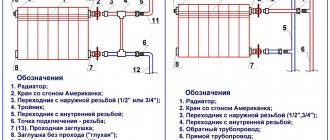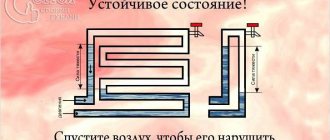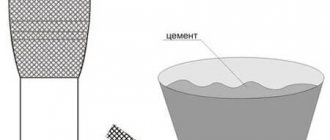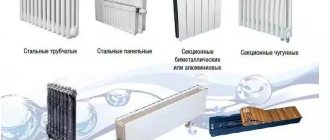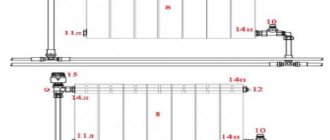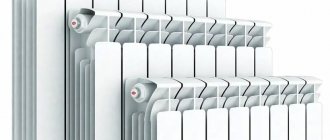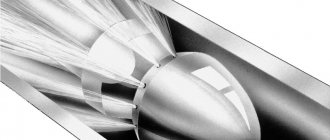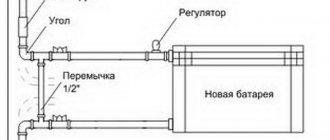Algorithm for cleaning the radiator
- We remove all unnecessary things and furniture from the heating radiator that may interfere with or delay flushing. If there are curtains hanging near it, you need to remove them. In addition, if the room uses laminate or parquet as flooring, then it is necessary to spread some piece of fabric or film under the radiator - this is done so as not to harm the floor.
Before starting work, you must turn off all taps
It is necessary to shut off the water supply to the radiator. If there is no shut-off valve that allows this to be done, then you will have to go the other way - drain the water from the heating system. Take a regular bucket, remove the radiator by unscrewing it from the rest of the equipment, and drain the water present in it into the prepared bucket. The cleaning process is just beginning and then you need to take the heating radiator to the bathroom and then place it in the bathtub. There is a risk of causing mechanical damage to it in the form of scratches, and in order to prevent such a development of events, place something like a wooden pallet under the radiator. If you live in a private house and not in an apartment, then to flush the radiator you will need to take it out into the yard.
The end fittings are unscrewed using a wrench
We unscrew the end fittings using a wrench. This must be done in the yard or in the bathroom, otherwise you can fill the floor with a cloudy and littered liquid that has a very unpleasant odor, and you will create another problem for yourself - you will need to clean the floor.
Next, you need to rinse the heating radiator from the inside; to do this, we supply water under pressure from a hose or shower into the holes at the end.
- Sometimes owners are forced to deal with crystalline blockages, and in this case slightly different means are needed. You can't do without a concentrated vinegar solution. We install the end fittings at the bottom and pour vinegar inside. Before using vinegar, it is recommended to dilute it 70% with water. This flushing will help remove stubborn blockages from the heating radiator. The solution should sit for about two hours, after which it should be poured out and the radiator should be cleaned with water pressure to achieve complete cleansing.
- You can also wash the external surfaces of the radiator to give it a nice and clean look.
One of the reasons for clogging may be scale formation
The radiator should be placed on wall mounts and the threaded connections on it should be lightly cleaned with a cloth, which must be dry. If you have a cast iron radiator, then screw tow onto all the fittings in the direction of the threads and apply paint to the seal. It is allowed to use any paint related to “Nitro” and “Enamel”. Using a two-piece gas wrench, tighten the fittings tightly. If the apartment has more modern radiators, then it is recommended to use film for waterproofing purposes. Do not use tow or paint.
So, as we see, there is nothing overly complicated about cleaning the radiator. This will not require any special skills or knowledge, just as you will not need any rare means and tools that are difficult to obtain. If done responsibly, this procedure will not take too much time and effort, and therefore every owner can clean the radiator on their own. However, there are situations where even after all the measures have been taken and the radiators are installed in their place, the heating system still functions poorly. In this case, you need to buy a new radiator and replace the old one, or use the services of specialized companies that carry out cleaning with a technical booster.
Cleaning cast iron radiators is not a problem
Rinse the cast iron heating radiator, as it is heavy, which in itself is inconvenient. In addition, due to the design features, it silts heavily.
To remove a cast iron battery you will have to work hard - as a rule, the connecting couplings and taps are rusted, so it will be difficult to unscrew them. Start by draining off any remaining water. To do this, unscrew the plug at the top, place a basin or other container under the bottom and begin to unscrew it easily.
We recommend: Hydrogen heating boilers: why you should not choose a hydrogen fuel boiler for heating a private home, review and comparison of efficiency and cost-effectiveness, the best models and their prices
Important!!! On cast iron radiators, the plugs can be with either left-handed or right-handed threads.
If the plugs are painted, use solvent or White Spirit to remove the paint from where it connects to the section. After that, try to unscrew it with a gas wrench. If it does not flow, use a rust converter, for example, WD-40.
When the remaining water has been drained, it is necessary to disconnect the cast iron radiator from the common line. Usually it is mounted on special couplings (see photo). As with plugs, couplings can also become rusty. Instead of couplings, valves, taps or fittings can be installed. In this case, you will need to unscrew them.
Such couplings usually connect pipes in heating systems with cast iron radiators.
It is best to wash a cast iron battery in a bathtub, which must be completely covered with rags or rags so as not to damage the enamel coating or acrylic.
First, clean the bottom and top using rags. You may need something like a metal rod to remove any stubborn dirt, especially at the bottom.
After this is done, you need to tighten the plugs at the bottom of the cast iron radiator and pour liquid or flushing solution into it. Let it sit for as long as required by the rules of use, then drain it by unscrewing the bottom plug.
Screw the cap back on at the bottom and fill all sections with hot water. Let it sit for 3-5 minutes and drain. Repeat the procedure until the water coming out is as clean as the water coming in.
The level of contamination of cast iron radiators is higher than bimetallic and aluminum ones. Therefore, repeat the cleaning procedure again. You may have to do this 3-4 times.
Battery flushing
It is most convenient to wash batteries in large containers . Considering the low weight of the products, the best option would be to process the equipment in a bath. The first cleaning is carried out without the use of chemicals . The radiator is filled with water and dirt is mechanically removed from it using shaking.
The spent contents of the device should be poured out , and special reagents should be poured . The solution is kept inside the battery for about an hour , after which the equipment is knocked with a wooden hammer or shaken to remove any remaining rust and dirt. At the end, the device is rinsed in running water .
Basic technology and sequence for flushing heating radiators
If you decide to flush the heating radiator yourself, then you will need a simple set of tools necessary for dismantling and installing the radiator, rags and a cast-iron bathtub. If you have an acrylic or cast iron bathtub installed, but have the opportunity to do it outside, you are incredibly lucky. In the case of a cast iron bathtub, everything is done in the following sequence:
- we remove the heating radiator - unfortunately, this is a necessary measure;
- we line the bottom of the bathroom with unnecessary rags to protect the enamel from damage, also for the safety of the sewer system, we install a mesh on the drain, which will protect the sewer from washed-out solid particles getting into it;
- we disassemble the mixer by removing the watering can from it, because for this procedure we need concentrated water pressure;
- We start flushing the radiator. To achieve the best effect, it must be turned periodically.
When flushing the radiator, you may have to additionally remove solid particles that need to be pushed through with a wire specially prepared for this purpose or other available means. Thus, it is necessary to flush the radiator until it is completely clean. This will be indicated by the clean water that will flow from them. As for washing on the street, to do this you need to extend a hose with water and do everything in the same sequence. Naturally, after washing the internal surface, it is necessary to clean the radiator from the outside, giving it an aesthetic appearance.
Very good results can be achieved by using special devices for flushing radiators. In this case, dismantling the radiators is not required. However, this method has a significant drawback - the high cost of equipment, which, given the infrequent work on flushing the radiator, is impractical to buy. Such devices are often used by utility services or construction companies, which have to deal with a similar problem quite often.
Flushing radiators using special equipment - video
If it happens that none of these methods suits you and rinsing with running water is impossible, you can do it differently. To do this, simply pour hot water into the radiator and add a cleaning agent; it is better to use soda ash for this. After about an hour, tap the radiator with a wooden hammer, drain the water and repeat this procedure several more times until it is completely clean. You can also use liquid for washing car radiators and whey for this, but such methods are used much less frequently.
When to clean heating radiators
The main indicator of comfort level is the room temperature. According to established standards, its minimum value for apartments and residential buildings is 18°C, but many begin to feel comfortable only when this indicator reaches 21°C, or maybe even higher. What to do if the temperature in the apartment is below the established standards, and representatives of utility services claim that they supply heat in full. Most likely, this is the case; the radiators in your apartment are simply clogged - a problem that occurs quite often. The following factors indicate that your radiators require flushing:
- when testing the heating riser, you suddenly discover that its temperature is much higher than the temperature of the heating radiators;
- in one room the radiators work at maximum efficiency, while in another they are barely warm or do not heat at all;
- it’s warm in your neighbors’ apartment, but you keep complaining about the quality of heating in your apartment;
- the heating radiator in its upper part is slightly warm, and its bottom is cold;
- Radiator sections do not warm up equally.
If at least one of these symptoms is detected, then it is necessary to begin “treating” your radiators.
This can be done in different ways, but it must be done, since you will still have to pay for heating. And what to pay for, you ask yourself a completely logical question. Thus, without delaying it, the problem must be solved. If you do not yet know how to flush a heating radiator, we recommend that you talk to specialists or carefully read these instructions.
Pneumopulse radiator cleaning
Cleaning process
Whatever cleaning agent is chosen for cast iron radiators, the washing procedure looks the same. How to wash cast iron radiators at home? To work with simple means you need to go through several steps:
First, you should free the radiator from the plugs and wash out all the dirt from it with plain water under pressure. It’s good if there is a water supply or a well with a tap. If not, then you can use a large-volume container and a deep-well pump
It doesn’t matter in what way, but pressure must be created. Next, you need to plug the radiator on three sides, and fill the internal cavities through the fourth hole with a solution of any caustic-based product. Place the liner in place and let it sit for a while with constant shaking of the radiator.
Caustic soda will rid the battery of organic dirt. Empty the device from liquid and, in the same way, fill in the citric acid solution. It is better to make this composition hot, so it will act on the sediment faster and more effectively and dissolve it. The radiator should be left in this state for three to four hours. But not at rest, it needs to be moved periodically. After the specified time, the solution must be drained and the battery lightly tapped on all sides. The plaque, softened under the influence of acid, will detach from the cast iron surface. It can be washed with plain water. Rinsing must be done until clean water flows from the battery.
In particularly difficult cases, when flushing the assembled radiator does not give the desired result, it is disassembled into separate sections. Cleaning is carried out one by one for each part separately. Only when reassembling it is recommended not to use old intersection gaskets; they must be replaced with new ones.
Types
Before cleaning the heating system, you first need to determine the metal of the batteries.
Aluminum radiators cannot be cleaned in the same way as copper-brass and cast iron ones. This is due to the fact that the former do not use solder in their construction and this metal reacts negatively to caustic soda.
Aluminum is a more reactive metal than copper-brass and can be dissolved with caustic soda. Because of this, these radiators undergo a different cleaning process.
As long as the coolant is replaced and flushed regularly, aluminum radiators do not require flushing.
Copper-brass and cast-iron radiators can be cleaned using any available methods.
How to clean an aluminum radiator
Use of chemicals
Aluminum is an extremely capricious metal. When choosing what and how to rinse aluminum radiators, you need to focus exclusively on the product whose composition will affect the deposits without affecting the walls themselves.
Chemical washing is good because it does not require dismantling the batteries and can be carried out even at the height of the heating season.
It is based on 2 stages of work:
- Dissolving scale.
- Flushing and removing them from the system.
The disadvantages of this type of cleaning include the increased toxicity of chemicals. When carrying out this procedure, you need to use protective measures and be very careful.
Attention is also required when diluting a chemical composition if it is sold as a concentrate. An incorrect proportion can destroy aluminum along with scale.
The most popular is the Master Boiler Power concentrate, which is suitable for all types of pipes and radiators. You can also use “folk” remedies, for example, vinegar, whey or caustic soda.
Find out useful information about aluminum batteries on our website:
Hydrodynamic flushing
This is one of the most labor-intensive ways to clean a heating system. It is based on a shock jet of water, under the pressure of which the scale peels off the walls of the radiator.
Sequence of work:
- The carrier is completely drained from the line.
- Areas that need to be washed are identified.
- Part of the pipe is removed, and in its place a hose with a special nozzle is connected, the end of which is inserted into the main line.
- Water under the action of a pump under high pressure is supplied to the radiator, sweeping away scale and all debris along the way.
After the cleaning is completed, the system should be filled with water and run through it several times to remove scale removed from the walls of the radiator.
Hydraulic flushing
This work can be carried out during the heating season, since it only requires running water through the system:
- Before starting work, a hose is connected to the drain valve, the second end of which is discharged into the drainage sewer system.
- The tap on the supply side opens and the layer of dirt disappears under the flow of incoming water.
- Cleaning can be considered complete once clean water flows through the system.
This method is used for regular cleaning of batteries. If the system has not been cleaned for a long time and the contamination is strong enough, it will not help.
Pulse washing
If the question is asked how to clean an aluminum heating radiator with minimal risk to it, then the answer is clear - using pulse washing.
This is a fairly “young” and progressive method that guarantees safety for the aluminum walls of heaters, but it requires special devices, so calling in specialists is indispensable.
The method is based on a short-term pulse effect on water, during which a shock wave is formed that moves through the system under a pressure of 12 atmospheres. This allows you to remove scale of any thickness without damaging the walls of the radiator, provided that it can withstand such water hammer.
This method is effective if:
- The diameter of the pipes does not exceed 4 inches.
- Even 60 m away from the device that creates the pulse effect, radiators are effectively cleaned of scale.
- Pulses do not affect the integrity of fittings and line components.
This flushing method increases the efficiency of the radiator by up to 25%, which practically returns the design to the parameters corresponding to the product that has just left the factory assembly line.
How to clean the outside
A good housewife makes sure that everything in her house is perfect, including the radiators of the heating system. To eliminate the need to frequently wipe dust in hard-to-reach places between segments, the batteries are covered with special screen boxes. If there is no such design, you will have to arm yourself with improvised means.
Dry cleaning
The procedure consists of using auxiliary tools that are found in every home:
- Vacuum cleaner. Thinking about how to wash the accordion battery inside, between the segments, nothing comes to mind except the ubiquitous vacuum cleaner. A reliable assistant will cope with dust deposits, and special small nozzles will make the process quick and comfortable.
- A hair dryer is a hair device that can blow out everything from the battery bins that have accumulated over the years. It should be mentioned that dust settled nearby will have to be removed with a vacuum cleaner.
- Pipidastra - a fluffy broom with cheerful colors is designed for brushing away dust from fragile things that cannot be wiped or this is due to a long, painstaking process due to the complexity of the shape. It will also help in the fight against dry dirt in the radiator.
Wet cleaning
- The sponge is used with water or detergent auxiliaries. You will have to try hard to reach hard-to-reach places of a complex-shaped product made of cast iron or other alloy.
- The brush is suitable for multi-row battery devices, such as bimetallic ones. In the gaps between the plates, a thin brush will easily go through and shake off the dust.
- A brush is convenient for cleaning holes, and to avoid splashes, just wrap the tool in a cloth.
- A microfiber or cotton cloth can also be used with water or liquid detergents.
- A kettle with boiling water will help rinse the entire product in the shortest possible time. You just need to place a tray under the battery to catch the draining liquid.
- A steam generator is a modern attribute that not every home has, but is a useful multifunctional assistant in everyday life. It will not only clean, but also remove all pathogens from the surface. The floor and wall behind the battery must first be covered with film and cloth. Textiles will absorb moisture that gets on it, and polyethylene will not damage the wallpaper or flooring.
Chemical and folk remedies that can be used to wash stubborn stains on the battery:
- vinegar;
- oxygen bleaches;
- liquid or dry substances marked “Anti-grease”;
- washing powder;
- a strong solution of laundry soap;
- baking soda paste;
- diluted chalk;
- citric acid - 3 tsp. for 200 ml of water;
- peroxide.
This is interesting: 9% table vinegar even fights mold, which is important in areas with a humid climate. It helps to wash away old dirt.
Tools for disassembling a cast iron device
Their list consists of:
- Radiator key.
- Chisels.
- Hammer.
- A small sledgehammer.
- Brushes with metal bristles.
- Blowtorch.
- Plumbing wrench No. 2,3. They need to unscrew the side plugs or plugs.
In many cases there is no radiator key. The situation is complicated by the fact that it is almost impossible to find in construction stores. Of course, it exists in the markets. Also, plumbers must have such a key.
The key itself is a round metal bar. which is 18 mm in diameter. One end is flattened and resembles a spatula. It has dimensions 28x40 mm. Thickness 6 mm. At the other end there is a welded ring. You need to insert a lever into it. As for the length of the key, it should exceed half the length of the radiator by 30 cm.
You also need to prepare several boards. Chocks may be suitable instead. They will be fitted with a battery before disassembly.
Tip: how to quickly wash a heating radiator – House cleaning
I came up with an express way to wash batteries. Take old socks, put them on your fingers, soak it all in detergent and wash it quickly. You can get into much more inaccessible places in the battery with your fingers than with just a rag. How do you like this method?
A wonderful way, but I make it even easier by wearing regular rag gloves and using them to wash dirty batteries. It’s better, of course, to wash it properly with a sponge, then wipe it dry. The main thing is to prevent dust from accumulating on the batteries.
It’s a great idea and it will really work out quickly, I wipe the glass this way, I find it comfortable with old socks, they are natural and wipe well, so now I’ll try to wash the batteries, they don’t get very dirty, but nevertheless there is somewhere for dust to hide.
What kind of batteries are these? I have old ones, cast iron. I somehow can’t imagine how you can do it with your fingers - it won’t take long to break them. I carefully push the rag in, push it with a stick, and use a toothbrush to reach somewhere. What about the fingers?
There are special brushes on sale for painting batteries; with this brush you can wash the battery, first spraying it with water from a spray bottle. Of course, I wouldn’t risk using a glove; you could get hurt very easily; a hand would be better.
I always sprinkle plenty of water on the batteries with a spray bottle; dirt and dust, along with this water, simply flow onto the floor. At the same time, I put a cloth on the floor. This is how I wash my batteries, I’ll try to buy a brush like this for painting, I’ll try to wash it like this.
I was pleasantly surprised by the idea of socks. I'll try. I always clean it with a vacuum cleaner first; by the way, I also have old cast iron batteries, then I wash it with soapy water and a rag, and then with clean water.
Then they dry on their own without wiping anything.
Old cast iron batteries are a real punishment when you start cleaning them. I usually wash with a rag and detergent. We have already replaced almost all the batteries with new ones; only two cast iron ones remain - I dream of getting rid of them. The new ones are much easier to clean.
I would also replace the batteries with new ones. Nowadays, steel radiators are mostly used, right? How do they hold heat compared to cast iron batteries? This question interests me extremely. They say it's much worse. And yes, there is much less fuss with them.
I can't imagine how to wash my cast iron batteries with socks. MB for other types of batteries is also an ingenious way. But I tried mine and only almost hurt my fingers. So I wouldn’t recommend washing cast iron ones in this way at all. But I wonder if there is a way to wash hot batteries
I wipe the batteries with a washcloth, but without fanaticism. Dust still remains in some places; you have to use different sticks to get it out. Recommend a way to wash the battery more effectively in hard-to-reach places. I have a cast iron...
uborka-doma.net
Flushing heating radiators made of cast iron, specifics and cleaning methods
In this publication we will talk about the ways in which you can wash outdated cast iron heating batteries. One of the good qualities of good cast iron radiators is considered to be a reliable service life. However, such a circumstance as blockage of heating devices leads to worse heating of the room.
Several factors influence battery clogging. But the main one is considered to be the occurrence of rust due to drainage of water from the heating system in the summer and poor quality of the coolant.
If the heating temperature of the heating pipes is very high, critically dirty heating devices will produce an extremely low heat rating. To eliminate this, it is necessary to carry out preventive measures at 15-20 years to clean heating devices from all kinds of contaminants.
Taking preventative measures to clean a multi-section cast iron radiator is not difficult, but not everyone can lift and dismantle the design of the radiator on their own. An excellent option would be to carry out this work with a plumber or assistant.
Another way out of the situation: disassemble the cast-iron sectional heating device into very small parts. In such a case, cleaning the radiator will not cause problems.
If the cleaning work will take place in a building with several apartments with centralized heating, you must make sure that the heating system is not turned on during the implementation of preventive measures. In a private house outside the city, a sufficient requirement would be to familiarize yourself with the weather forecast for the next few hours or days.
Basically, soda ash dissolved in hot water is used to clean the battery. To prevent the solution from spilling out of the heating device, it is necessary to install specialized plugs at the ends of the radiator. Moreover, you need to shake the battery a little and leave it for about an hour.
Another stage consists of tapping all sections of the heating device with a wooden hammer (mallet). This is necessary to separate rust and growths that have peeled off due to the action of soda ash from the surface inside the heating unit. Then you should remove one of the foot plugs and replace it with a rubber hose connected to the water meter unit. Next you need to remove the second plug. The tap of the water meter unit must be fully opened to create a powerful stream of water that will wash out all the debris from the heating device.
If you use a compressor to carry out this procedure, the efficiency of the work process will be increased. The soda ash solution can definitely be replaced with ordinary whey from milk, which also helps to peel off all kinds of contaminants in the middle of the heating device.
Soda ash can also be replaced with a liquid or cleaner for a car heater. But in this case, you will have to carefully study the instructions in order to correctly calculate the required dosage according to the volume of the heating device.
From the very beginning, liquid is poured into the radiator design to flush cast iron heating radiators, then hot water is added there. The battery needs to be kept in this state for about 2 hours, but every 10 minutes you will have to magically move the parts. At the end of 2 hours, the cast iron sectional heating device must be thoroughly washed using a flexible hose and running water.
To keep the heating device clean, you can use a trick and install an outlet with a plug in front of the inlet. In such a case, rust particles will attach to the magnet installed on the outside. Let's watch the video. Thanks to such actions, all dirt and corrosion will be attracted to a specific place and will not enter the battery. Of course, a similar plug must sometimes be cleaned and put back. But the measures taken in the future will prevent the entire battery from being cleaned.
How to manually remove old paint from a battery
Cast iron radiators, due to their long service life, are periodically tinted. The high temperature with which the material is constantly in contact forces the coating to warp and all this takes on an unpresentable appearance.
There are several ways to quickly get rid of the old protective layer on cast iron:
- A paint remover such as white spirit will do the job. But you will have to sweat, washing everything or making lotions with this substance. The drug has a strong, unpleasant odor, so the procedure must be performed with the windows open.
- Sandblasting is not difficult if you have a special device, which is rare. Just stick the nozzle into the radiator, and it will do everything itself.
- Construction hair dryer - refers to thermal methods and can damage the rubber seals between the segments.
- A brush attachment on a drill is not the easiest method of mechanical cleaning, but it is effective. The main thing is not to overdo it, otherwise you can damage the cast iron.
To avoid having to clean radiators frequently, you need to choose a special heat-resistant paint.
Once you know how to clean your battery inside and out, you should be patient and take time before organizing an event. In both cases, the process is lengthy and sometimes dangerous. Especially if cleaning is carried out during the heating season. When you have doubts about your own abilities, it is better to seek help from a plumber.
Outside
How to rinse cast iron radiators, as well as all others? You can clean up the outside of the radiator using several methods - it all depends on the degree of contamination.
Dry cleansing
Everything we cover here is more suitable for everyday cleaning. For general purposes, more serious methods are needed. So, there are two simple and effective ways:
- Using a vacuum cleaner. It’s very good if you have special attachments - because the battery sections are sometimes very close to each other, so you can’t get to them with a regular floor brush.
- Using a hair dryer. In this case, a damp cloth of suitable size is attached between the wall and the radiator. Air from the device simply blows dust between the battery sections onto this cloth. Then it remains to carefully remove the material and rinse it from dust.
Wet cleansing
How to clean a heating battery when it is very dirty? If you want to do high-quality spring cleaning, then this is the place for you. First of all, we focus on the degree of contamination of the radiator:
Light to medium soiling. Before wet cleaning, it is best to carry out dry cleaning, which we described above. It is advisable to use hot water, even boiling water. Be sure to find a container of suitable size that can be placed under the entire duration of the battery - water will flow into it
Then, from another container, carefully pour boiling water over the battery, section by section. After the water has drained from it, it is additionally dried with prepared rags, napkins
Washing areas between sections. To ensure that wet cleaning reaches areas between sections that we physically cannot reach with our hands, it is best to use a steam mop (pictured). Some housewives additionally spread cotton napkins for better steam absorption. As an option, you can wrap a rag around a pointer, a stick, a narrow handle, or a nozzle for something and, moistening it in water, clean hard-to-reach areas.
Heavy contamination. Anti-fat agents are used. An aqueous solution is first prepared from them, which is poured into a spray bottle or spray bottle and thoroughly sprayed over a moistened battery. Then some time is given to “acidify”. After which the cleaning solution is completely removed with water and rags from the surface of the battery.
Dismantling
You can clean cast iron batteries yourself. Although this can save a significant amount of money, it is hard work and does not guarantee that the central heating system will be completely flushed. Probably after a while the blockage will make itself felt again and you will have to call a plumber.
How to wash cast iron batteries by hand:
- Turn off the central heating system and leave it to cool for a few hours. Radiators can be filled with very hot water, which can cause serious burns.
- Place old towels around the radiator and pans under the radiator so that all dirty water drains into it.
- Turn the valves on both ends. You should be able to turn the thermostatic radiator valve (to adjust the temperature) by hand, but you may need to use a wrench to turn the other valve (the shut-off valve), which will have a removable plastic cap. Make a note of how many turns it takes to close them, as you will need to turn them back the same number of times as when removing them.
- With these valves removed, proceed to remove the nuts that connect the thermostatic valve to the radiator. Then, using the key, open the release valve. Be prepared for a stream of dirty water.
- Transport the heating radiator into a bathtub or outside. If you are cleaning in the bathroom, place an unnecessary rag on the bottom and cover the drain hole with a mesh so that it does not become clogged with rust and dirt. Ask someone to help if the device is too heavy.
Dismantling is completed, you can begin cleaning cast iron or aluminum batteries.
Radiator cleaning
Let's imagine what the cleaning procedure will look like under different conditions.
Washing with a special device
To quickly and effectively clean radiators “without leaving the cash register,” there are special devices for washing them. Of course, having such a device for infrequent cleaning of a home battery is essentially a luxury.
The device operates from the mains - it drives water into the radiator with a powerful jet, which with its pressure removes scale, rust, grease, and various chemical deposits. But if you don’t have this device, you can replace it by cleaning the radiator in the bathtub.
Washing algorithm in the bath
How to wash batteries in an apartment without being able to take them outside? The instructions will consist of the following blocks:
- Filling with hot water. You will need to use a hose, shower, watering can, kettle with a narrow spout, or a regular funnel to pour hot water inside the radiator. Open both plugs to allow dirty water to flow out freely. Once there is enough liquid in the battery, shake it and pour out all the contents. The action should be repeated until large pieces of dirt fly out of the radiator being cleaned. It is worth noting that the procedure is difficult to perform alone - the weight of the battery is significant even for a brave athlete. Therefore, 1-2 assistants in this matter are vital for you.
Pouring cleaning agent. The second step is to pour the cleaning agent you have already chosen into the radiator, diluting it with water
Now it is important to put plugs on all the holes in the battery so that the “useful liquid” does not leak out of it. Depending on the drug, it is left to “acidify” for a period of 2 hours. As soon as the active component has expired, you need to shake the radiator again
You can knock on its various parts with a wooden, plastic, or rubber hammer. This will help further remove rust and other contaminants from its internal parts.
Now it is important to thoroughly rinse the cleaning agent. Therefore, it is necessary to clean until the foam stops coming out, the smell stops being felt, or other characteristic features of its presence are manifested in some other way.
If you do not rinse the radiator completely, the active components of the product will continue to act, destroying the metal from the inside, which will cause leakage and failure of the battery.
The videos in this article will show you how to clearly follow the instructions.
Features of cleaning in a private home
Cleaning batteries in your homes is even more important than in apartments. This is due to a number of heating features:
- The coolant is water from a well, borehole, or even a reservoir. Hence, there is more coarse dirt stuck in the radiator than in the water circulating through the lines of city heating systems. Therefore, the need for cleaning arises much more often.
- Not only the radiator is washed (blown), but also the heating main. After all, all the debris stuck in it will invariably end up in the cleaned battery.
- In case of urgent need, you can clean the radiator during the heating season. Otherwise, during the cold season, it makes no sense to turn off the heating system for cleaning.
Features of flushing during the heating season
If you decide to clean the battery during the cold season, then pay attention to the following:
- The cleaning method and detergents are the same.
- It is possible to flush radiators (in a private house) without removing them and without draining the water from the heating boiler:
- Disconnect the steam line completely while cleaning.
- Perform a purge.
- Put all the valves back on, and then run water through the thermal circuit.
- Feed it until absolutely clean water flows out of the pipeline.
The measures taken will clean not only the radiator, but also the entire heating line in general.
Thus, cleaning the radiator without removing it is only possible in your own home. Residents of apartments will have to remove it to clean the battery from the inside. An exception is for those who have a special device for cleaning batteries.
Features of radiators
In new or old Khrushchev-type apartments, cast iron batteries, so-called accordions, are installed predominantly. They are famous for their long service life and remain warm for some time after the hot liquid has ceased to be renewed. Cast iron withstands pressure drops in the system and poor-quality contents more easily. But such radiators are also more expensive.
Products made from bimetallic material are cheaper, thinner, and lighter. They are distinguished by increased heat transfer, but also cool quickly. They are easier to clean from the outside and look more attractive from an aesthetic point of view.
They don’t clog as often because they are made of a smoother material to which less dirt sticks. But bimetallic batteries more often burst, unable to withstand a sudden surge in pressure in the system. This is not uncommon at the beginning of the heating season or during sudden temperature changes. Therefore, they are preferred to be used in private homes or commercial buildings.
Aluminum products are the cheapest, but they are fragile and short-lived. Apartments with old heating systems quickly lose their functionality.
During the maintenance process, each type of battery must be considered individually.
How to disassemble a cast iron radiator
The joints of the old battery are quite strong. In many cases, they “grow together” in such a way that strength alone is not enough. Therefore, before disassembling the battery, it should be placed on boards and properly prepared.
The simplest preparation involves heating the joint. To do this, use a hair dryer or a blowtorch. The latter can burn old paint. However, it's not scary.
More serious preparation involves heating the metal to such an extent that it begins to glow. After this they try to unscrew the nipple. This can be done both when the alloy becomes very hot, and when it has cooled noticeably. The second option is even better, because during cooling the gasket becomes covered with cracks and the strength of the connection becomes weak. He is often shown in videos.
To disassemble a battery made of cast iron, you need to perform the following steps:
- Unscrew the plugs (plugs).
- Place the radiator key on top of the device so that the flattened end rests on the nipple. Make a mark on the key where the battery ends using chalk or electrical tape.
- Insert the key inside the bottom hole.
- Turning it along the axis to the right and left, insert it into the product up to the drawn mark.
- Determine which way the nipple is screwed. To do this, bait it with the right and left sides. If you manage to bait it with the right side, then you need to unscrew it counterclockwise.
- If you manage to move the nipple, then make one revolution. Next, a similar procedure is done with the nipple at the other end of the section.
- Both nipple nuts are unscrewed in turn. Otherwise the section will crack.
- In the same way, you need to unscrew all sections.
If it was not possible to disassemble the heating battery in this way, you will have to saw through the section that is leaking. At the same time, they saw it in the center of the nipple. The work is carried out by picking up a grinder or a hacksaw.
Another option is to break the bad section with a sledgehammer. You need to break the middle part of the section. The nipple, which remains unharmed, is unscrewed using a plumbing wrench. It can also be knocked out using a hammer and chisel. Then you need to clean the threads in entire sections.
Heat meter for a battery How to choose a solar battery for your home Screens for a heating battery Which heat regulator can be installed on a battery
Classification
Radiator cleaning procedures are divided into different types, depending on the auxiliary means used and the area of influence.
There are significantly more options, but only those that can be done independently and at home without the use of specific equipment will be covered.
Outdoor
It is used to refresh the appearance of the product, remove accumulated dust, dirt and renew the top protective layer of paint. In turn, it happens:
- Chemical - requires the use of active substances that enhance the effectiveness of cleaning with a damp sponge or microfiber cloth.
- Mechanical - used to remove the outer coating for the purpose of updating it. The following tools are used: grinder, brush, sandpaper, etc. Using additional means, you should pay special attention to the joints of the sections and the line with the battery, so as not to damage them.
- Thermal - also used to remove a layer of paint from a cast iron battery. An industrial hair dryer or blowtorch does the job faster, but it also affects the rubber sealing gaskets between the segments. If you do not want to disassemble the battery into sections, it is better to abandon this method.
Internal
Responsible for the quality of heat transfer from the radiator and its throughput.
- The mechanical method requires the use of a brush or wire with a hook, with the help of which the limestone build-up is cleaned or chipped off. In this case, specialists use a blowing station. Then the product is washed with water from the inside and mounted in its original place.
- Chemical is often performed after mechanical to enhance the effectiveness of the latter, but it can also be an independent procedure. It requires the mandatory use of an active substance that will dissolve or weaken the structure of deposits inside the product.
Important: in some cases, dry cleaning will not give the expected result, because under the influence of temperature, a conglomerate is formed that cannot be washed off with anything. The only solution is to buy a new heat exchanger.
Cleaning batteries using special equipment
Cleaning cast iron batteries without removing them can be done using special equipment. The following complex equipment is intended for domestic needs:
- pneumatic pistol "Typhoon";
- device for electrohydropulse influence ZEVS-24;
- cleaning device Krot-Mini.
Air pistol "Typhoon"
Flushing the battery with a Typhoon pneumatic gun
The equipment is compact and easy to use. It is used to perform targeted impact on blockages in water and sewer pipes with a diameter of up to 150 mm. The essence of the process is a hydraulic ram to remove hardened deposits from the walls of equipment and adjacent risers with a shock wave at a speed of 1.5 km/h, which spreads over a distance of up to 60 meters.
Pneumatic pistol "Typhoon" in action
This cleaning of the heating system allows you to completely remove contaminants that are not amenable to conventional hydraulic flushing.
"Typhoon" is indispensable as a plumber's tool for clearing blockages in various hard-to-reach places. Depending on the configuration and weight, the device has 6 modifications and the following indicators:
- internal cleaning diameter up to 150 mm;
- maximum firing range to the target is 60 m;
- special valve design for kinetic ramming;
- pressure gauge on the body;
- Possibility of manual inflation.
Comprehensive flushing of heating batteries
As a rule, “Typhoon” is used in conjunction with the ZEVS-24 automatic installation and the Krot-Mini device for cleaning hard-to-reach objects.
Installation ZEUS-24
ZEUS-24 has small dimensions and sufficient power to destroy hardened heating devices, internal and external water supply and sewerage networks that are firmly stuck to the inner walls. The essence of its work is based on the electrohydropulse effect on solid contaminants in pipes with a diameter of 7 to 150 mm. The electrical discharge created by the device leads to the generation of a shock wave and powerful hydrodynamic flows that act on hardened clogs, scale and deposits.
Procedure for hydropneumatic flushing of heating radiators (batteries)
- destruction of blockages of any strength;
- safety of the equipment being cleaned;
- cleaning of hard-to-reach bent and spiral pipes;
- wear resistance of manufacturing materials;
- protective shutdown on the plug.
Krot-Mini device
The device has the following advantages:
- ability to work with various drums and spirals with a diameter of 6 to 13 mm;
- easy drum replacement procedure;
- to facilitate work, the distribution pipe is located inside the drum;
- automatic spiral feed;
- durable and flexible spiral made of hardened steel cable, entwined with hardened steel wire;
- high torque allows you to remove stubborn dirt;
- standard equipment consists of 4 different nozzles, allowing for complete cleaning of pipes and removal of foreign objects;
- For use in wet rooms, the device is equipped with an RCD.
Flushing heating batteries with the Krot-Mini device
How to ensure warmth and comfort in your home depends on everyone’s choice and preferences. You can extend the life of old equipment or replace it with new, more modern one.
Cleaning radiators and eliminating blockages
If, after turning on the heating, the temperature in the room begins to rise more slowly, and the radiator sections are barely warm, this is most likely due to clogging of the heating radiators. This article will tell you how to clean a radiator with your own hands.
Before starting work, prepare all the necessary tools and materials.
For cast iron radiators you will need:
- Gas wrench No. 2 (designed to work with pipes with a diameter of 25 to 50 mm).
- Adjustable wrench. Or a set of open-end wrenches. They are more convenient to work with, but the set is heavier than one adjustable one.
- Paint (FUM), or better yet, red lead.
- Sealing tow (preferably linen).
- Volumetric capacity.
Summary of how to wash to maintain the functionality of the system
Repairing cast iron radiators is possible on your own, but only for minor defects. If you do not have the necessary tools or do not have enough experience, contact professional plumbers.
In addition to state-owned ones, there are many private companies with a 24-hour emergency call service.
All home leak repairs and repairs are temporary.
Therefore, after the end of the heating season, invite specialists to replace damaged sections or the entire radiator. The faster this is done, the safer your home will become.
In apartments and private houses, heating systems lose their efficiency over the years, which leads to a decrease in the quality of home heating. Among all the most common causes of this phenomenon, experts highlight the problem of radiator contamination. There is a fairly simple explanation for this: the coolant, during circulation through the heating circuit, contributes to the destruction of the inner surface of the heating devices.
In addition, the water contains some impurities that can settle inside the heat exchangers. This results in contamination, blockage and, accordingly, a reduction in the useful volume of radiators, which leads to a decrease in the efficiency of their operation. And the only correct solution (with the exception of replacing heat exchangers with new ones) is flushing the heating radiators.
Signs of dirty radiators
Unsatisfactory quality of the coolant (for example, excessive water hardness) leads to problems in the operation of the heating system.
There are five signs of pollution:
- One radiator gets hotter than the other. If one battery is cooler than the others installed in the room, this indicates contamination of the channels through which the coolant is transported.
- The battery temperature is lower than the riser. This sign alone indicates a malfunction of the device.
- The heating of the room has become worse, although everything is fine with the neighbors. If the apartment is cold, this does not always mean that the heating network is not doing its job well. As a rule, the reason is clogging of communications.
- The bottom of the batteries is cold. If radiators heat up unevenly, this means it’s time to clean their channels.
- Different temperatures of sections in one radiator. It happens that the channels become dirty only in certain sections. It will not be possible to clean them individually, because the entire system requires periodic maintenance.
